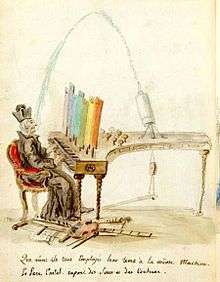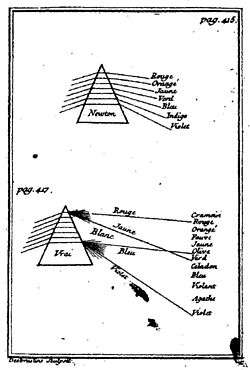Louis Bertrand Castel
Louis Bertrand Castel (5 November 1688[1][2] – 11 January 1757[3][4]) was a French mathematician born in Montpellier, who entered the order of the Jesuits in 1703. Having studied literature, he afterwards devoted himself entirely to mathematics and natural philosophy. After moving from Toulouse to Paris in 1720,[5] at the behest of Bernard de Fontenelle, Castel acted as the science editor of the Jesuit Journal de Trévoux.[6]
| Part of a series on the |
| Society of Jesus |
|---|
 Christogram of the Jesuits |
| History |
| Hierarchy |
| Spirituality |
| Works |
| Notable Jesuits |
|
|
He wrote several scientific works, that which attracted most attention at the time being his Optique des couleurs (1740), or treatise on the melody of colours. He also wrote Traité de physique sur la pesanteur universelle des corps (1724), Mathématique universelle (1728), and a critical account of the system of Sir Isaac Newton in 1743.
Philosophical approach
Louis Bertrand Castel wrote on areas as wide-ranging as physics, mathematics, morals, aesthetics, theology and history. His philosophical approach attempted to reconcile fields and viewpoints. Castel based much of his work on analogical thinking, seeking to understand the physical and moral worlds through the discovery of analogies.[4]
Castel's first major published work was his Traité de physique de la pesanteur universelle des corps (1724). He first attempted to systematise physical phenomena, through the mechanical action of universal gravity. He then considered a mechanistic world-view's shortcomings, from a theological and metaphysical perspective. He held humanity as central to natural philosophy, in that humans are embodied spirits whose actions, chosen with free will, affect the world around them and each other. In emphasising free will and the actions of mankind Castel attempted to counter deterministic views of man and nature.[4]
Castel considered that true science should focus on readily experienced and described phenomena. His emphasis on the description and analysis of the perceived world was consistent with analogic thinking and phenomenal explanation. Castel actively opposed the idea of a science based on experimental methods, instruments, speculation and theorising.[4]
The Ocular Harpsichord

Early on, Castel illustrated his optical theories with a proposal for a Clavecin pour les yeux (Ocular Harpsichord, 1725). A new series of articles, published in the Mercure de France in 1735, gave his idea wider currency.[7] In 1739 the German composer Telemann went to France to see Castel's Ocular Harpsichord for himself. He ended up composing several pieces for it, as well as writing a description of it.[8]
The ocular harpsichord had sixty small coloured glass panes, each with a curtain that opened when a key was struck. A second, improved model of the harpsichord was demonstrated for a small audience in December 1754. Pressing a key caused a small shaft to open, in turn allowing light to shine through a piece of stained glass.[9][10] Castel thought of colour-music as akin to the lost language of paradise, where all men spoke alike, and he claimed that thanks to his instrument's capacity to paint sounds, even a deaf listener could enjoy music.[11]
Criticism of Newton


It was in 1740 that Louis Bertrand Castel published a criticism of Newton's spectral description of prismatic colour[12] in which he observed that the colours of white light split by a prism depended on the distance from the prism, and that Newton was looking at a special case. It was an argument that Goethe later developed in his Theory of Colours.[13][14]
See also
References
- Schier, Donald Stephen (1941). Louis Bertrand Castel, anti-Newtonian scientist. Cedar Rapids, Iowa: The Torch press. p. 3. Retrieved 28 November 2016.
Louis-Bertrand Castel, second son of Guillaume Castel, physician, and of his wife, Louise, was born at Montpellier on the fifth of November, 1688. Footnote: And not on the eleventh as stated in the eulogy of Castel, Journal de Trevoux, April 1757, p. 1100. The fifth is the date given in the parish records of the church of Notre Dame in Montpellier. These records are now in the municipal archives.
- Kipnis, Igor (2006). Harpsichord and clavichord : an encyclopedia. New York: Routledge. ISBN 0415937655.
- Schier, Donald Stephen (1941). Louis Bertrand Castel, anti-Newtonian scientist. Cedar Rapids, Iowa: The Torch press. p. 57. Retrieved 28 November 2016.
He died on the eleventh of January, 1757. Footnote: This is the date given in his eulogy in the J. de T., April, 1757, pp. 1114–1115. Other dates given are the ninth and the twelfth. See J. de T., January, 1759, p. 357.
- Richard, Jean-Olivier (2015). The Art of Making Rain and Fair Weather: The Life and World System of Louis-Bertrand Castel, SJ (1688–1757),. Baltimore, Maryland: Johns Hopkins University. p. 1. Retrieved 28 November 2016.
- Rose, Hugh James (1857). A New General Biographical Dictionary. London: B. Fellowes, &c. p. 107.
- Hankins, Thomas L. (1994). "The Ocular Harpsichord of Louis-Bertrand Castel; Or, The Instrument That Wasn't". Osiris. 9 (Instruments): 141–156. doi:10.1086/368734. JSTOR 302003.
- Franssen, Maarten (1991). "The Ocular Harpsichord of Louis-Bertrand Castel". Tractrix. 3: 39. Retrieved 28 November 2016.
- Descriptions of an Eye-Organ or the Eye-Harpsichord Invented by the Famous Herr Pater Castel, 1739, as cited by Elder, R. Bruce (2008), Harmony and Dissent: Film and Avant-garde Art Movements in the Early Twentieth Century, Film and Media Studies, 3, Wilfrid Laurier Univ. Press, p. 54, ISBN 9781554580286.
- "Color and Music" (PDF). Music Theory 21. Retrieved 28 November 2016.
- McDonnell, Maura (2002). "Visual music". Colour and Sound.
- Peel, James (2006). "The Scale and the Spectrum". Cabinet. Winter (22). Retrieved 28 November 2016.
- Castel, Louis-Bertrand (1740). L'Optique des couleurs. Paris.
- Hankins, Thomas L.; Silverman, Robert J. (1995). Instruments and the Imagination. Princeton University Press. ISBN 0-691-00549-4.
- O'Connor, John J.; Robertson, Edmund F., "Louis Bertrand Castel", MacTutor History of Mathematics archive, University of St Andrews.
